Roasted veggies with brown rice make a colorful and nutritious meal you'll love. Choose seasonal veggies like bell peppers, zucchini, and carrots for a blend of textures and flavors. Toss them in olive oil and your favorite seasonings, then roast at 425°F until caramelized. While those roast, rinse your brown rice and cook it with a 2:1 water ratio for a nutty base. Serve the veggies over the rice, and consider adding a protein for balance. With endless customization options and flavor enhancements, you can truly make this dish your own—more ideas on how to elevate your creation await.
Key Takeaways
- Select a mix of colorful, seasonal veggies like bell peppers, zucchini, and carrots for balanced flavor and texture when roasting.
- Preheat your oven to 425°F and toss uniformly cut veggies in olive oil for even caramelization.
- Cook brown rice using a 2:1 water ratio for 45-50 minutes for a light, nutty base.
- Enhance your dish with seasonings, herbs, or sauces like balsamic glaze for added depth and richness.
- Serve roasted veggies over brown rice and consider adding protein like grilled chicken or chickpeas for a complete meal.
Benefits of Roasted Vegetables
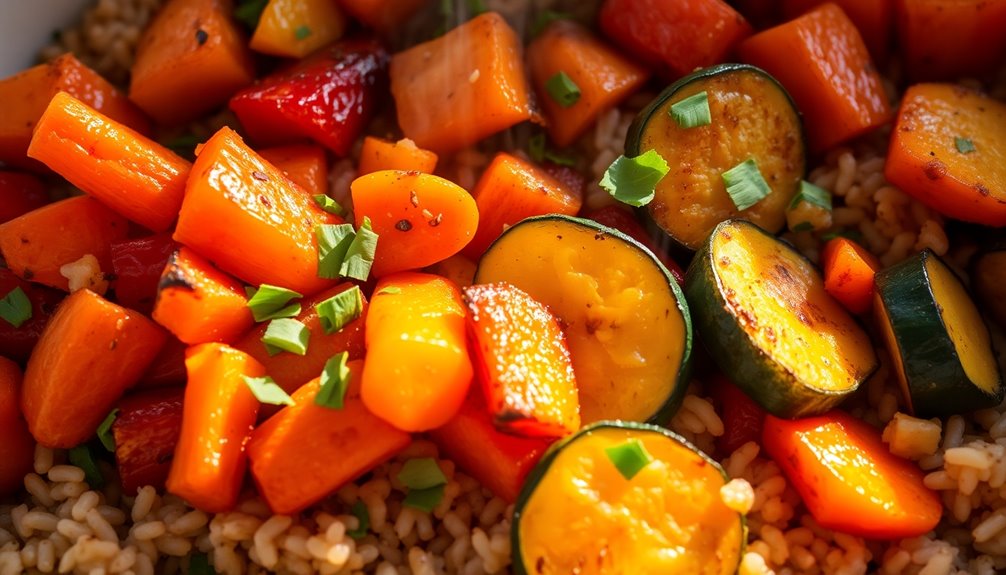
Roasted vegetables aren't just a tasty addition to your meals; they pack a powerful nutritional punch that can elevate your overall health. When you toss seasonal veggies in olive oil and your favorite spices, you're not only enhancing their flavor but also revealing a treasure trove of health benefits.
One of the key nutrition benefits of roasted vegetables is their rich supply of vitamins and minerals. Carrots, bell peppers, and broccoli, for example, are excellent sources of vitamin A, C, and K. Roasting helps to concentrate these nutrients, making each bite a flavorful boost to your immune system and overall well-being. Plus, the process of roasting can help soften the fibers, making it easier for your body to digest and absorb these essential nutrients.
In addition to their nutritional perks, roasted vegetables offer taste advantages that can transform any meal into a culinary delight. The caramelization that occurs during roasting amplifies the natural sweetness of the vegetables, giving them a rich, savory flavor that you won't get from steaming or boiling.
The delightful crunch and vibrant colors can make even the pickiest eaters excited about their veggies.
Choosing the Right Vegetables
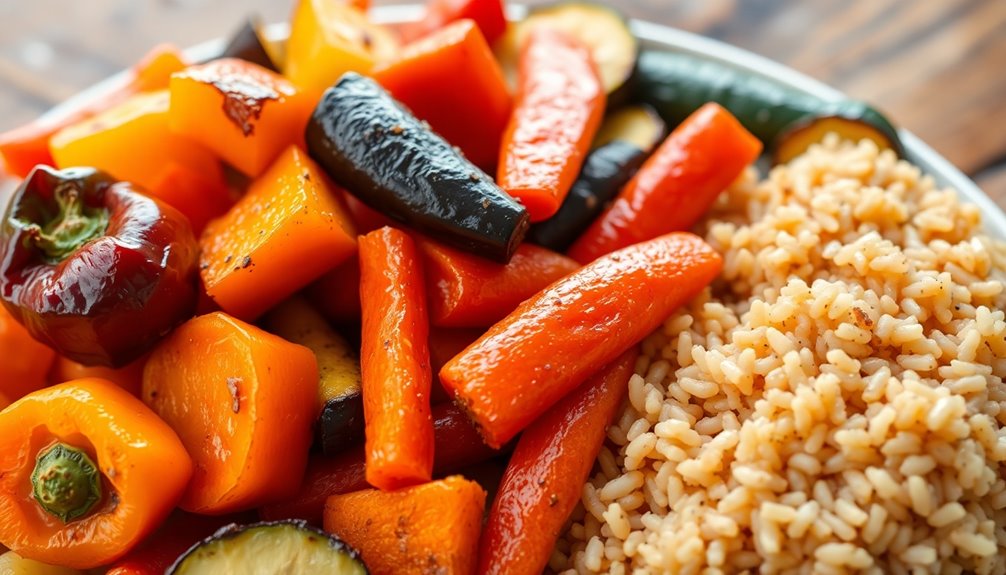
When you're planning to roast veggies, the main thing is selecting the right ones to maximize flavor and nutrition. Start by thinking about your texture preferences. Do you enjoy the crispiness of roasted Brussels sprouts or the creaminess of roasted sweet potatoes? Each vegetable brings its own unique texture to the table, so mix and match to create a delightful medley that satisfies your palate.
Next, consider the vibrant colors and flavors that can transform your dish. Bell peppers, zucchini, and carrots not only add visual appeal but also complement each other beautifully in taste. Don't shy away from seasonal veggies; they often taste better and provide a sense of connection to the earth's cycles.
Once you've chosen your veggies, think about seasoning options. Olive oil, garlic, and herbs like rosemary or thyme can enhance the natural flavors of your chosen vegetables. A sprinkle of sea salt and freshly cracked pepper can work wonders, too. Experiment with different combinations to find what resonates with your taste buds.
Preparing Brown Rice
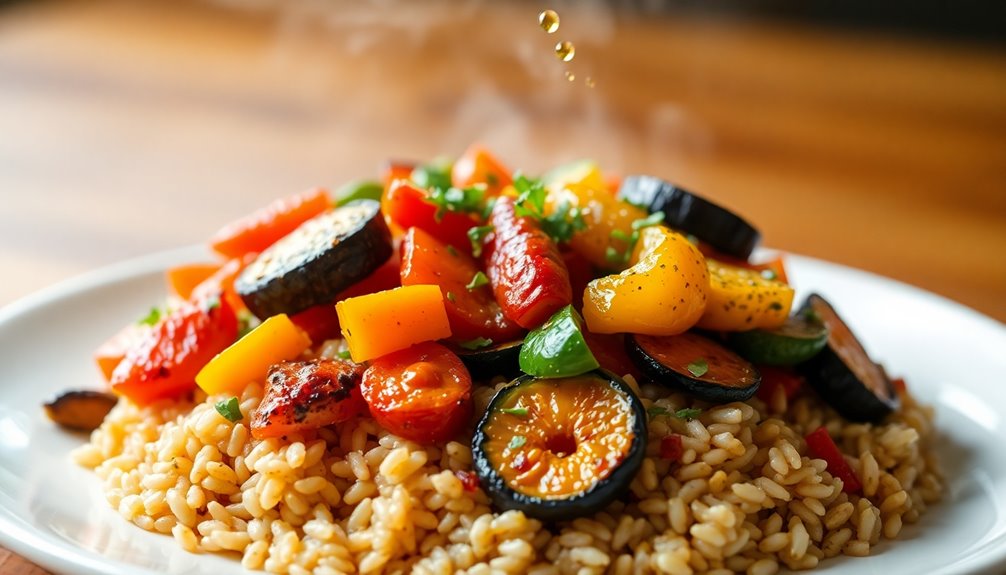
Often disregarded, preparing brown rice can enhance your roasted veggie dish to a whole new level. This nourishing grain offers a robust base that complements the lively flavors of your veggies. Let's delve into how to prepare it flawlessly, guaranteeing you achieve that perfect texture and taste.
- Rinse the Rice: Start by washing your brown rice under cold water. This step eliminates excess starch, preventing it from becoming sticky as it cooks.
- Water Ratio: For brown rice, you'll need a water proportion of 2:1. That means for every cup of rice, use two cups of water. This will allow the rice to soak up enough liquid, resulting in a tender grain.
- Cooking Time: Unlike white rice, brown rice requires a lengthier cooking time—usually about 45-50 minutes. Bring the water to a boil, then lower the heat to low, cover, and let it simmer. Patience is crucial here; have faith that your rice is evolving into a light, nutty addition to your dish.
Once it's done, let the rice rest for a few minutes before fluffing it with a fork. This straightforward process ensures your brown rice isn't only tasty but also a wholesome companion to your roasted veggies. As you savor your meal, you'll feel a sense of connection to a community that values nutritious, homemade dishes. So, roll up your sleeves and let's start cooking!
Roasting Techniques
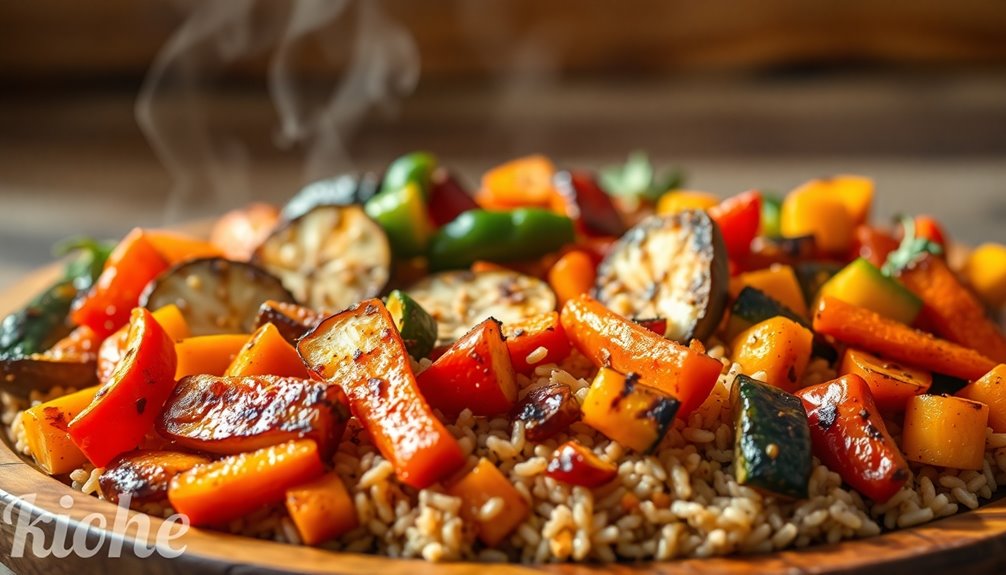
Mastering roasting techniques can elevate your veggies from ordinary to extraordinary. When you roast vegetables, you're not just cooking; you're creating a warm, inviting dish that brings everyone together. Start by preheating your oven to around 425°F (220°C) for that perfect caramelization.
Cut your veggies into uniform pieces to ensure uniform cooking. Think about using a mix of colors and textures—carrots, bell peppers, and zucchini all roast beautifully. Once you've got your veggies prepped, toss them in olive oil. This not only helps with browning but also allows the flavors to meld beautifully.
Now, let's talk seasoning options. You can keep it simple with salt and pepper, or get adventurous with garlic powder, paprika, or even fresh herbs like rosemary and thyme. Remember, a good seasoning can transform your dish into a delightful experience.
Cooking times vary depending on the type of vegetables you choose. Root vegetables like potatoes may take about 30-40 minutes, while softer veggies like asparagus might only need 15-20 minutes. To achieve that perfect roast, flip your veggies halfway through their cooking time for even browning.
As you pull that golden tray out of the oven, your kitchen will be filled with mouthwatering aromas. Enjoy the satisfaction of serving up veggies that not only taste great but also make everyone feel at home. Roasting is more than just a technique; it's a way to create warmth and connection around the dinner table.
Flavor Enhancements
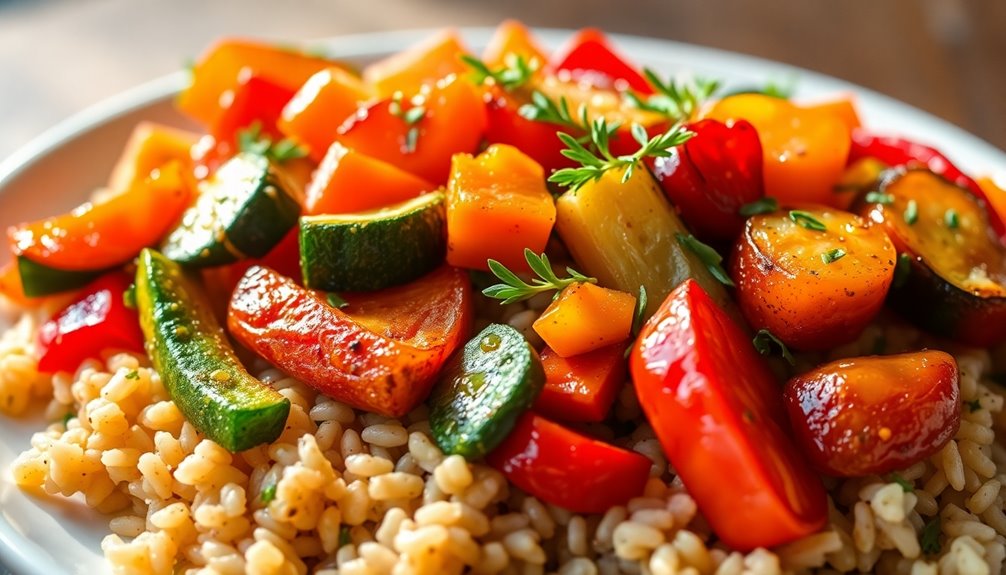
After you've perfected your roasting techniques, it's time to take your veggies to the next level with some flavor enhancements. You can elevate your roasted veggies through thoughtful seasoning options and creative ingredient pairings that cater to your taste preferences. Here are three ideas to inspire you:
- Herb Infusion: Fresh or dried herbs like rosemary, thyme, and oregano can add depth and aroma. Toss your veggies in olive oil and sprinkle your chosen herbs before roasting. The result? A fragrant dish that'll make your kitchen feel welcoming.
- Zesty Marinades: Experiment with marinades that incorporate citrus juices, garlic, and soy sauce. Marinate your veggies for at least 30 minutes before roasting. This method not only intensifies flavors but also introduces a delightful tang that complements the natural sweetness of roasted vegetables.
- Spice Blends: Embrace bold flavors by trying different spice blends, such as smoked paprika, cumin, or curry powder. These cooking methods introduce warmth and complexity, making your veggies pop with personality. Feel free to adjust the spice level based on your taste preferences.
Serving Suggestions
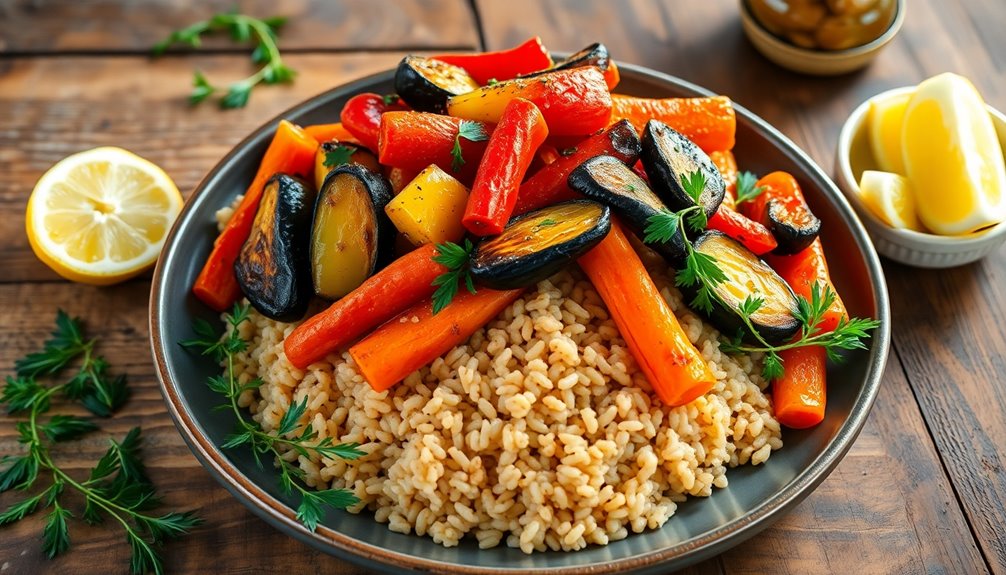
When it's time to serve your roasted veggies, think beyond the plate and consider how they can complement your meal. These vibrant, flavorful vegetables deserve a spotlight, and with a few pairing options and presentation ideas, you can elevate your dining experience.
One great approach is to serve your roasted veggies over a bed of brown rice. This not only adds texture but also makes your dish hearty and satisfying. You can also mix in some protein, like grilled chicken or chickpeas, for a more balanced meal. Don't forget about utilizing leftovers! You can repurpose them into wraps, salads, or grain bowls for easy meal prep throughout the week.
Here's a handy table to inspire your serving suggestions:
| Pairing Options | Presentation Ideas |
|---|---|
| Grilled chicken | Serve in a colorful bowl |
| Quinoa or couscous | Layer on a platter |
| Hummus or tzatziki | Garnish with herbs |
| Feta or goat cheese | Use vibrant dishes |
| Nuts or seeds | Create a rustic spread |
Storage Tips
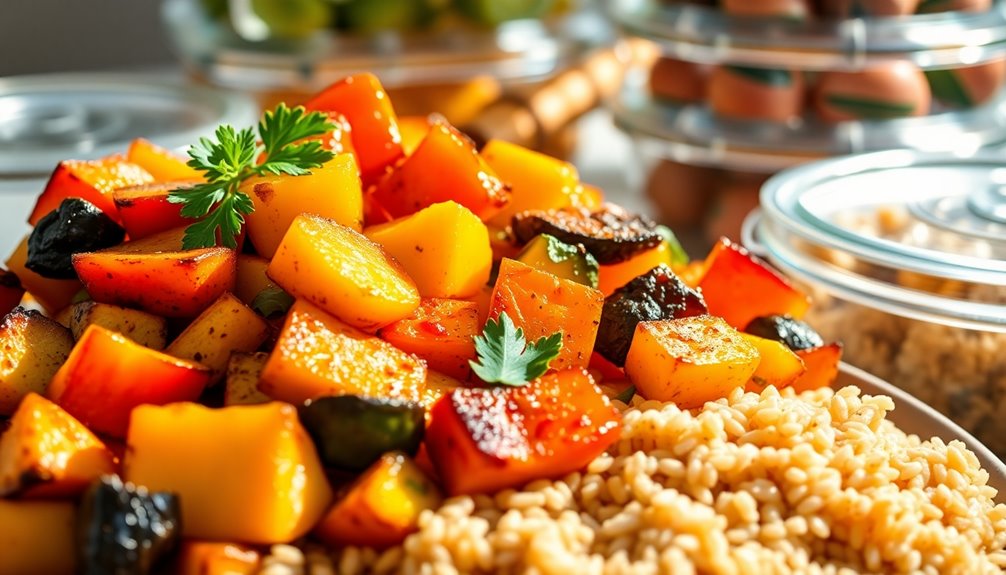
Proper storage is crucial for keeping your roasted veggies fresh and flavorful. Whether you're enjoying them as part of a meal prep routine or saving them for later, following these tips will guarantee they stay delicious and vibrant.
- Cool Before Storing: Allow your roasted veggies to cool completely before putting them in the fridge. This prevents condensation, which can lead to sogginess and spoilage.
- Use Airtight Containers: Choose airtight containers for storing your veggies. Not only do they keep the air out, but they also prevent your veggies from absorbing other odors in the fridge, preserving their unique flavor.
- Label and Date: If you're freezing leftovers, be sure to label and date your containers. This way, you can easily keep track of what you have and when you made it, so nothing gets lost in the back of the freezer.
When you store your roasted veggies properly, you can look forward to enjoying them throughout the week. They make for quick and easy additions to any meal, enhancing your dishes without extra effort.
Plus, if you've prepared too many, freezing leftovers is a smart way to minimize waste. You'll always have a tasty, nutritious option ready to go, making meal prep even more enjoyable.
Embrace the convenience of leftovers, and savor the flavors of your roasted veggies for days to come!
Variations and Customizations
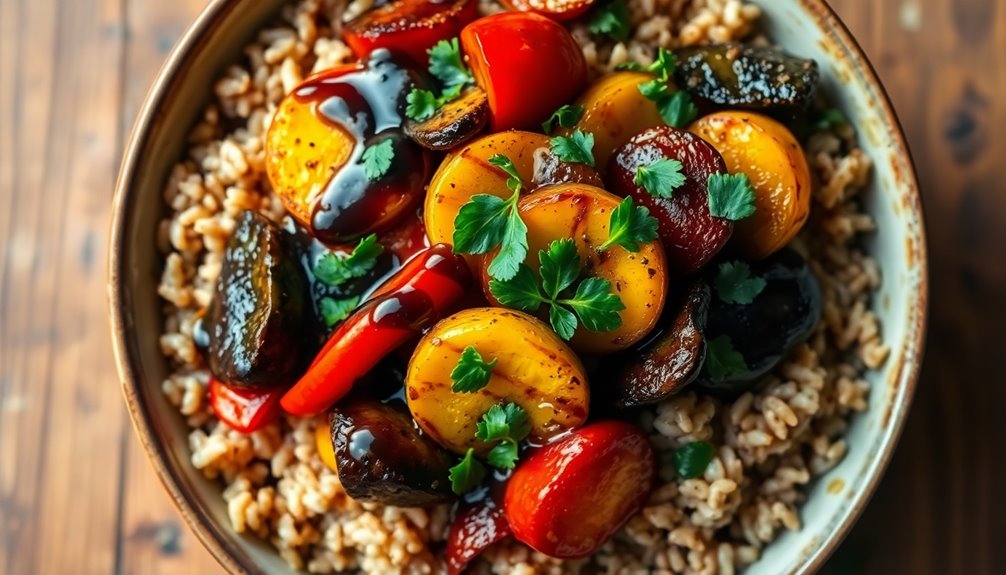
If you're looking to elevate your roasted veggies, consider experimenting with different seasonings and ingredients to create a dish that suits your taste. The beauty of roasted vegetables lies in their versatility. You can easily switch things up by trying various seasoning options. For instance, a sprinkle of smoked paprika can add depth, while a dash of cumin lends a warm, earthy flavor. Don't shy away from fresh herbs either; rosemary or thyme can bring a delightful freshness that transforms your dish.
Ingredient swaps are another fantastic way to customize your roasted veggie experience. Instead of the usual carrots and zucchini, why not experiment with seasonal produce? Think about swapping in Brussels sprouts or butternut squash for a unique twist.
You can also play with textures by incorporating nuts or seeds, like walnuts or sunflower seeds, which not only enhance the flavor but also add a satisfying crunch.
Feeling adventurous? Try drizzling a bit of balsamic glaze or tahini sauce over your finished dish for an extra layer of richness. Each bite can tell a different story based on the choices you make, reflecting your personality and preferences. So gather your favorite veggies, mix and match seasonings, and embrace the joy of creating a roasted veggie dish that feels uniquely yours. You'll not only impress your taste buds but also create a meal that invites others to share in your culinary journey.
Frequently Asked Questions
Can I Use Frozen Vegetables Instead of Fresh for Roasting?
You can definitely use frozen vegetables instead of fresh for roasting! While fresh veggies often have vibrant flavor profiles, frozen produce can still deliver great taste and nutrition benefits. Just adjust your cooking techniques slightly; you might want to thaw and pat them dry to avoid excess moisture.
Roasting frozen veggies can create a delicious caramelization, bringing out their natural sweetness. You'll enjoy a satisfying dish that's both convenient and nutritious!
How Long Can I Store Leftovers in the Fridge?
Imagine your fridge as a treasure chest, holding onto the freshness of your leftovers. You can safely store them for 3 to 5 days, ensuring they maintain their vibrant flavors.
When you're ready to indulge again, reheat them using gentle methods like the oven or stovetop, which preserve their delicious essence.
Embrace the joy of savoring your culinary creations, knowing each bite brings warmth and comfort back into your day.
Is Brown Rice Gluten-Free?
Yes, brown rice is gluten-free, making it a great option for those with gluten sensitivities. Its nutritional value is impressive, packed with fiber and essential nutrients that support your health.
You can prepare it using various cooking methods, like boiling or steaming, to enhance its nutty flavor. Plus, it pairs well with many dishes, catering to diverse taste preferences.
Enjoying brown rice can help you feel connected to healthier food choices in your meals.
What Kitchen Tools Do I Need for Roasting Vegetables?
Did you know that 80% of people say they enjoy cooking more when they've the right tools?
To roast vegetables like a pro, you'll need a sturdy baking sheet, high-quality knives, and a set of mixing bowls.
Don't forget to grab your favorite best seasonings for that extra flavor!
Keep an eye on roasting times to achieve that perfect caramelization, and you'll create delicious dishes that everyone will love.
Can I Roast Vegetables in an Air Fryer?
Absolutely, you can roast vegetables in an air fryer! It's a fantastic alternative to traditional oven roasting techniques. The air fryer circulates hot air, giving your veggies a crispy texture while keeping them tender inside.
Just toss your favorites in a bit of oil and seasoning, set the temperature, and let it work its magic. You'll enjoy a delicious, quick dish that brings everyone together around the table for a shared, healthy meal.
Conclusion
Incorporating roasted veggies with brown rice into your meals is not just delicious; it's also incredibly nutritious. Did you know that roasting vegetables can elevate their antioxidant levels by up to 25%? Picture a vibrant plate filled with caramelized carrots, sweet bell peppers, and earthy brown rice, all working together to nourish your body. So, why not embrace this colorful dish? It's not just a meal; it's a celebration of flavors and health on your plate.



